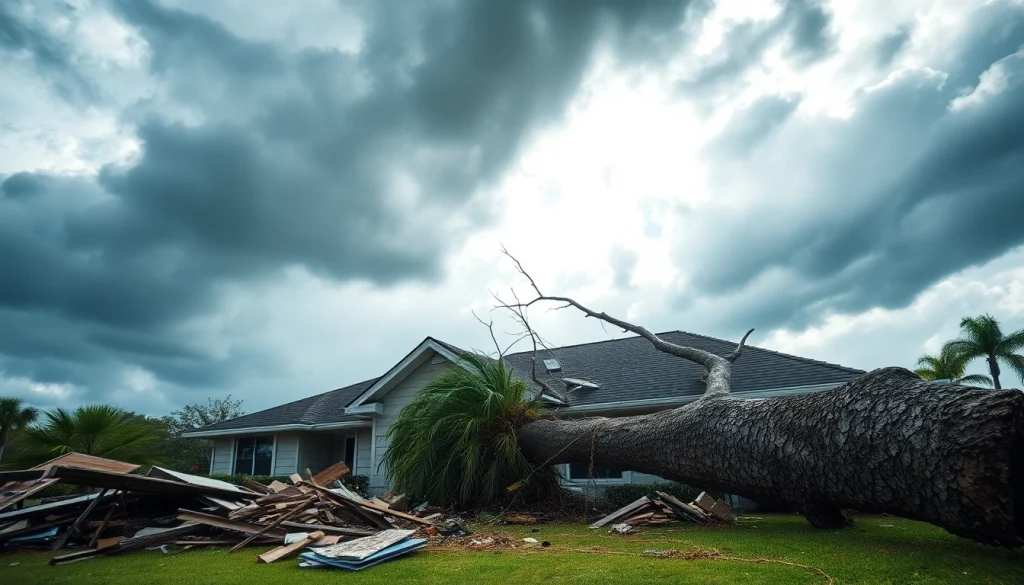Introduction to Florida Hurricane Damage
Florida is well-known for its beautiful beaches, vibrant wildlife, and year-round sunshine. However, it is also infamous for experiencing significant hurricane activity, particularly during the Atlantic hurricane season. Understanding Florida Hurricane Damage is crucial for homeowners and communities alike, as the impact of these storms can be devastating, leading to structural issues, loss of property, and the disruption of daily life.
What Constitutes Hurricane Damage?
Hurricane damage encompasses various forms of destruction that various storms can inflict, including wind, rain, storm surge, and flooding. Specifically, hurricane damage might include:
- Wind Damage: High winds can tear off roofs, break windows, uproot trees, and damage power lines.
- Water Damage: Heavy rainfall can lead to flooding, which can ruin flooring, walls, and personal possessions.
- Storm Surge: The rise in seawater level during a storm can cause severe coastal flooding, leading to extensive property damage.
- Physical Impacts: Debris propelled by hurricane winds can strike buildings, damaging exteriors, windows, and more.
The effects of hurricane damage are not limited to physical destruction; they extend to emotional and financial tolls as well, impacting the lives of those affected for years to come.
The Impact of Florida’s Geography on Storm Severity
Florida’s unique geographic location plays a significant role in the intensity and frequency of hurricanes. Situated between the Gulf of Mexico and the Atlantic Ocean, the state is often a prime target for storms developing in warm waters. The peninsula’s length and shape can funnel storms, increasing their wind speeds as they approach land.
Moreover, Florida’s coastal elevation is generally low, which makes it particularly susceptible to storm surges. This geographic vulnerability contributes to the state’s high levels of hurricane damage, especially in areas prone to flooding. Population density along the coast further exacerbates the situation, making the effects of hurricanes feel more catastrophic.
Common Types of Florida Hurricane Damage
When a hurricane strikes Florida, specific damages are more commonly observed:
- Roof Damage: One of the most significant types of damage occurs to roofs. Wind can lift shingles, leading to leaks and further internal damage.
- Structural Damage: This includes serious issues such as cracked foundations or compromised walls, often caused by high winds and flooding.
- Flooding Damage: Excessive rainfall and storm surges can overwhelm drainage systems, flooding homes and businesses.
- Landscape Damage: Trees and landscaping can sustain severe damage, posing risks to both homes and power lines.
Causes of Florida Hurricane Damage
Understanding Hurricane Formation and Path
Hurricanes are fueled by warm ocean waters and atmospheric conditions that allow organized winds to develop. Understanding the formation process of a hurricane is key to anticipating its potential damage. The primary causes of hurricane intensity and landfall are:
- Ocean Temperature: Hurricanes typically form over warm ocean waters (at least 80°F), which provide the necessary energy to fuel the storm.
- Wind Patterns: Atmospheric wind currents can steer and intensify hurricanes, affecting their trajectory and severity.
- Humidity: High levels of humidity in the atmosphere can contribute to the development of hurricanes, allowing them to grow and strengthen as they move toward land.
Weather Patterns That Intensify Storms
Specific weather patterns also play a critical role in intensifying storms. The Madden-Julian Oscillation, El Niño and La Niña phenomena, and vertical wind shear effect hurricane activity, influencing their formation and strength:
- El Niño/La Niña: These climate patterns regularly impact sea surface temperatures and atmospheric conditions, influencing hurricane frequency and severity.
- Vertical Wind Shear: Low vertical wind shear (the change of wind speed and direction in a defined area) can allow hurricanes to develop more organized and powerful storm systems.
- Atmospheric Pressure Systems: High and low-pressure systems interact to create the conditions necessary for hurricanes to intensify or weaken.
Factors Contributing to Localized Damage
Localized hurricane damage can be attributed to several factors:
- Geographic Features: Mountains and valleys can shield certain areas from wind or water damage, while others might amplify these forces.
- Urban Planning: Poor urban planning can lead to inadequate drainage systems, exacerbating flooding issues.
- Building Codes: Structures not built to withstand hurricane winds may experience more severe damage, leading to greater overall loss.
Assessing the Extent of Florida Hurricane Damage
Initial Damage Evaluation Techniques
After a hurricane, a systematic evaluation of damage is essential to determine the necessary response and recovery efforts. Initial damage assessment involves:
- Visual Inspections: Conducting on-site inspections to evaluate visible damage to the exterior, roof, and foundation of houses and commercial properties.
- Photo Documentation: Taking photos to document damage for insurance claims and recovery planning.
- Neighborhood Assessments: Assessing nearby structures and debris can provide insights into the storm’s impact on a larger scale.
Tools for Comprehensive Damage Assessment
For a deeper understanding of the extent of hurricane-induced damage, professionals often utilize various tools and technologies:
- Drone Technology: Drones can quickly and effectively survey hard-to-reach areas, offering detailed insights into property and landscape damage.
- 3D Imaging: Scanning technology can create detailed 3D models of structures, allowing for precise assessment of impacts.
- Remote Sensing: Satellite imaging and aerial views can reveal widespread areas affected by flooding or wind damage.
Importance of Professional Inspections
While homeowners can perform initial evaluations, professional inspections are vital following a hurricane:
- Expertise: Professionals have the training to identify hidden damages not easily visible to the untrained eye.
- Comprehensive Reports: Damage assessments conducted by professionals typically yield detailed reports necessary for filing insurance claims.
- Safety Checks: Professionals can ensure that buildings are structurally sound and safe to enter.
Preventative Measures Against Florida Hurricane Damage
Home Fortification Best Practices
Homeowners can take specific steps to fortify their properties against potential hurricane damage:
- Roof Reinforcement: Using hurricane straps and impact-resistant shingles can significantly increase roof strength against high winds.
- Shutter Installation: Installing storm shutters can protect windows from flying debris and wind pressure.
- Landscaping Adjustments: Properly maintaining trees and removing any weak or dead branches reduces the risk of falling on structures during a storm.
Insurance Considerations for Property Owners
Insurance is a crucial element of hurricane preparedness:
- Comprehensive Coverage: Homeowners should ensure they have comprehensive coverage, including flood insurance, which is often separate from standard homeowner policies.
- Policy Review: Regularly reviewing and understanding the policy limits and exclusions can prevent surprises during the claims process.
- Documentation: Maintaining an inventory of household items and properties provides essential information for claims following a hurricane.
Community Preparedness Programs
Community programs play an essential role in enhancing preparedness and safety:
- Emergency Response Plans: Communities should develop and regularly update emergency response and evacuation plans.
- Public Education: Engaging community members in preparedness workshops can increase awareness and reduce risks during hurricane season.
- Resource Centers: Establishing local resource centers can provide vital information regarding evacuation routes, shelters, and recovery resources.
Restoration and Recovery from Florida Hurricane Damage
Steps for Effective Disaster Recovery
After the storm, recovery from hurricane damage requires methodical steps:
- Safety First: Always prioritize safety and avoid entering damaged buildings until confirmed structurally sound.
- Contact Insurance: File claims as soon as possible to expedite recovery efforts, providing all necessary documentation.
- Seek Disaster Assistance: Explore local, state, and federal resources that may be available to help with recovery.
Choosing the Right Restoration Professionals
Selecting capable restoration professionals is vital for a successful recovery:
- Research and Reviews: Look for highly-rated companies with verified credentials and customer testimonials.
- Get Estimates: Always obtain multiple estimates and do not rush into agreements without understanding the terms.
- Check Insurance Leadership: Ensure that any contractors or professionals used are licensed, insured, and familiar with local building codes.
Long-term Strategies for Hurricane Resilience
Ensuring long-term resilience against Florida hurricane damage involves a combination of community efforts and personal responsibility:
- Infrastructure Improvements: Invest in community infrastructure improvements to better withstand future storms.
- Environmental Restoration: Engage in environmental initiatives such as restoring wetland buffers and natural coastlines to reduce hurricane impacts.
- Ongoing Education: Continuous community education on preparedness measures fosters a culture of resilience against future events.





